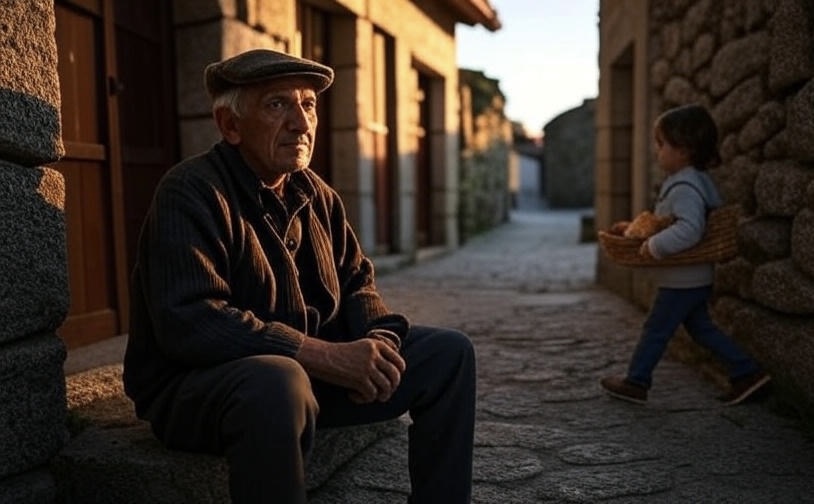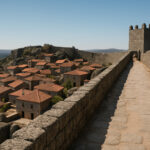Portugal’s countryside is studded with enchanting medieval villages that seem untouched by time. Perched on hilltops or tucked in rugged valleys, these storybook hamlets invite discerning travelers to step into ages past. Cobbled lanes, ancient stone houses, and formidable castle walls whisper legends of knights and kings. Far from the usual tourist routes, these villages offer an immersive journey into Portugal’s feudal heritage – from whitewashed cottages draped in bougainvillea to hilltop fortresses guarding panoramic horizons. And with Portugal Magik Private Tours, you can experience these treasures in comfort and depth, whether on a tailored day trip or a leisurely multi-day expedition crafted just for you.
1. Óbidos
Estremadura region – about 1 hour north of Lisbon
Óbidos is a perfectly preserved walled village that feels like a fairy tale come to life. Whitewashed houses trimmed with blue and yellow, overflowing with geraniums and ivy, line a maze of medieval streets. The village’s 12th-century castle crowns the hill, its sturdy ramparts encircling tile-roofed cottages, Gothic doorways, and cozy bookstores. By day, stroll along the castle walls for panoramic views of vineyards and orchards below; by night, feel the old stone streets come alive under lamplight. Don’t miss tasting the local cherry liqueur, ginjinha, served in a chocolate cup – a sweet Óbidos tradition. Originally a wedding gift to a Portuguese queen, Óbidos exudes romance and history at every turn, making it an essential stop for anyone seeking Portugal’s medieval charm.
2. Monsaraz
Alentejo region – overlooking Lake Alqueva
Set high on a hill in the rural Alentejo, Monsaraz is a crown of white houses and castle ramparts with sweeping views over olive groves and the shimmering Alqueva Lake. Entering this village is like stepping into a painting: narrow cobblestone lanes lead past chalk-white cottages, medieval arches, and an ancient bullring still used for summer festivals. The silence is broken only by church bells and the whisper of the wind across the plains. At sunset, Monsaraz offers an awe-inspiring spectacle as the sky turns gold over the Guadiana River valley – it’s no wonder this area is certified as a Dark Sky Reserve, perfect for stargazing. Wander the castle grounds at dusk, and you’ll see why Monsaraz is often called one of Portugal’s most romantic medieval villages. For wine lovers, the surrounding region boasts prestigious wineries (like Herdade do Esporão), so you can easily combine history with a taste of Alentejo’s famous wines on your visit.
3. Marvão
Alto Alentejo – near the Spanish border
Marvão’s ancient gate: The stone gateway of Marvão’s hilltop fortress welcomes you into a village above the clouds. This tiny walled town sits atop the Serra de São Mamede like an eagle’s nest, offering jaw-dropping views of the surrounding valleys and distant Spain. Within Marvão’s walls, time moves slowly. Steep, winding streets of pale granite lead to a medieval castle that appears carved from the very bedrock. You’ll find flower-lined alleys, whitewashed houses with Gothic windows, and quiet courtyards filled with the scent of rosemary. Standing on Marvão’s castle ramparts, you can gaze out over the Alentejo plain – a vista so vast that Portuguese poet José Saramago mused it’s like looking at “the back of a sleeping giant.” Despite its breathtaking beauty, Marvão remains peaceful and uncrowded. Be sure to explore the small museum and nearby Roman ruins of Ammaia down the hill for a deeper dive into the region’s past. In Marvão, with its cool mountain air and storybook tranquility, you truly feel as if you’ve entered a castle in the sky.
4. Sortelha
Beira Interior (Central Portugal)
Sortelha is a medieval time capsule nestled among granite boulders. Encircled by 13th-century walls, this village has changed so little in 800 years that you might imagine a knight on horseback could appear at any moment. Pass under the arched stone gate and you’ll find narrow lanes paved with uneven rock, leading to a tiny square with an ancient pillory and sun-drenched cottages built from massive granite blocks. There are no modern buildings inside Sortelha – only the weathered medieval houses and the impressive ruins of a hilltop castle watching over them. Climb the old fortress steps to survey the landscape: rolling highlands and distant mountains of the Serra da Estrela. The silence is profound. In the local tavern, you might sample a glass of licor de medronho (a traditional strawberry-tree liqueur) as villagers swap stories. Visiting Sortelha is to step back in time – a pure and authentic glimpse of Portugal’s early history, virtually untouched by the modern era.
Soaring stone towers in Sortelha: The medieval castle keep of Sortelha still stands guard over the village, its crenelated towers and sturdy walls a reminder of the region’s strategic importance in ages past. Exploring these well-preserved fortifications offers a tangible connection to the 1200s, when Sortelha’s battlements protected the border of the young Portuguese kingdom. From up here, every direction offers a postcard-perfect view – red rooftops within the walls on one side, and on the other, the wild beauty of central Portugal’s hills unfolding to the horizon. Sortelha’s castle is not just an artifact; it’s part of the village’s living fabric, and walking its perimeter at sunset, with swallows diving overhead, is an experience that will linger in your memory.
5. Belmonte
Beira Alta – near Covilhã, Serra da Estrela
Belmonte is a unique blend of medieval heritage and enduring Jewish history. This hillside village, dominated by a rugged 13th-century castle, was the birthplace of Pedro Álvares Cabral – the explorer who discovered Brazil in 1500. History runs deep here. For centuries, Belmonte was home to a secret community of Jews (the Belmonte Marranos) who practiced their faith in hiding during the Inquisition. Today you can visit the Jewish Museum and a restored 17th-century synagogue in the old Jewish quarter to learn this fascinating story of survival. Walking Belmonte’s old streets, you’ll see carved symbols on lintels – evidence of Jewish families from long ago – alongside Catholic chapels and stately stone houses. The castle of Belmonte, with its lone pentagonal tower, offers lovely views of the Zezere Valley and Serra da Estrela peaks. Inside, it houses a small museum and occasionally hosts cultural events. Belmonte’s atmosphere is tranquil and reflective. It’s a place to contemplate how different cultures intertwined in Portugal’s past. Tip: Combine a trip here with a drive through the Serra da Estrela Natural Park; the mountains are just next door, offering scenic beauty to complement Belmonte’s historical riches.
6. Castelo Rodrigo
Northeastern Beira – overlooking the Douro River
Castelo Rodrigo is a walled medieval village perched high on a hill in Portugal’s far northeast, where the vistas stretch across the Spanish border. Once a thriving frontier stronghold, this tiny village today enchants visitors with its golden-stone houses and timeless rural ambiance. Wander up to the ruined castle keep and you’ll pass the old cistern, a medieval well that sustained the village through sieges, and the remains of the Palace of Cristóvão de Moura (a long-ago governor). One of Castelo Rodrigo’s gems is the spiritual legacy of its diverse inhabitants: you can find the roofless shell of a 15th-century synagogue and nearby, a small chapel with beautiful azulejo tilework. Don’t forget to stop by local shops – the surrounding region is famed for almonds, honey, and olive oil, and villagers eagerly offer tastings of their products. As evening falls, Castelo Rodrigo glows in the setting sun, its ramparts bathed in warm light. It’s an unforgettable experience to stand at the miradouro (viewpoint) just outside the walls, where you can watch the sky turn crimson over the distant Douro Valley vineyards.
7. Trancoso
Beira Alta region (Central Interior)
Trancoso is a medieval walled town that thrived as a market outpost and sanctuary for Portugal’s Jewish community. Encircled by stout walls you can still walk on, Trancoso’s old center is a warren of stone houses carved with symbolic motifs. At the heart stands the Igreja de São Pedro and the 16th-century pillory in the square, where medieval fairs once took place. Trancoso’s castle, with its imposing gate towers, provides an excellent view of the entire fortified town. As you explore the lanes, you’ll notice engraved stone stars of David and Hebrew inscriptions – clues to Trancoso’s significant Jewish heritage. The modern Isaac Cardoso Interpretation Center just outside the old walls celebrates this history, featuring a beautifully rebuilt synagogue and exhibits on the life of the secret Jews (Cristãos Novos) who lived here after the Inquisition. Beyond history, Trancoso has a lively local culture; if you visit during one of its annual festivals or the weekly market, you’ll catch a slice of authentic rural Portuguese life amid the medieval backdrop. Between the historic castle, the echo of ancient commerce, and the legacy of its Jewish quarter, Trancoso offers a deeply layered journey into the past.
8. Linhares da Beira
Foothills of the Serra da Estrela
Linhares da Beira is a sleepy medieval village high on the slopes of Portugal’s tallest mountain range. This granite hamlet is famed for its 12th-century castle, whose two sturdy towers dominate the landscape and once guarded the Mondego River valley below. Today, Linhares is wonderfully quiet and unspoiled – a place where you can wander stone alleys lined with quaint, lichened houses and feel as though you have the whole village to yourself. History and nature intersect beautifully here. In addition to exploring the castle – climb up for a breathtaking panorama of mountains and clouds – Linhares is known as Portugal’s paragliding capital due to the favorable updrafts along the ridge. On a clear day you might spot colorful paragliders silently drifting over the village, a modern echo of the birds soaring above the ancient battlements. Stop by the 12th-century Romanesque church to admire its austere architecture, and peek into the tiny museum in the old town hall. Every corner in Linhares exudes authenticity, from the communal washbasin once used by villagers to the grain mills just outside town. For travelers seeking an off-the-beaten-path experience, Linhares da Beira delivers medieval charm amid a majestic natural setting.
9. Piódão
Serra do Açor (Central Portugal)
Piódão is perhaps Portugal’s most picturesque secret – a remote village hidden in the folds of the Açor mountains, built entirely of dark schist stone. From afar, Piódão looks like a cluster of little slate boxes cascading down a green mountainside, often earning it the nickname “Nativity Village” for its striking appearance under starry skies. Wander the zigzagging footpaths (there are almost no cars in the historic core) and you’ll be enchanted by stone cottages with bright blue-painted doors and windows – a local tradition that adds a splash of color to the earthy tones. The 17th-century parish church, painted white, stands out like a beacon in the village center. Nature envelops Piódão: crystal-clear springs trickle through the hills, terraced fields hug the slopes, and several hiking trails lead to viewpoints and waterfalls in the surrounding woods. Life here carries on in age-old rhythms – you might see villagers baking bread in a community oven or herding goats on the terraces. Visiting Piódão is a step into a living postcard, ideal for travelers who appreciate scenic beauty, photography, and the quiet dignity of an isolated rural life that has changed little over the centuries.
10. Almeida
Beira Interior – near the Spanish border
Almeida offers a different twist on the medieval village: it is a star-shaped fortress town, famous for its perfectly preserved 12-point defensive walls. From above, Almeida’s fortifications form a star pattern – an ingenious design from the 17th century, though the settlement’s history reaches back much further. Enter through the impressive double gates and you find a neat village within, with tidy streets laid out after the medieval period, lined by barracks, churches, and stone houses that echo the military past. Stroll along the ramparts to appreciate the scale of the fortification, complete with dry moats and outworks that once thwarted invading armies. Down in the heart of town, you can visit the Picadeiro Real (former royal riding hall) and an excellent small museum in the old powder magazine, which vividly recounts the Great Siege of Almeida during the Napoleonic Wars. Yet despite its later history, Almeida has medieval roots – visible at the site of the old castle ruins at the town’s center (tragically blown up in an 1810 magazine explosion). As you walk through underground escape tunnels or peer out from a bastion at the plains stretching to Spain, you’ll sense how strategic this village has always been. Tip: Almeida pairs well with nearby Castelo Rodrigo or the village of Marialva, creating a fantastic route through Portugal’s historic border defenses.
11. Marialva
Northern Beira / Douro region
Marialva is a ghostly beautiful medieval village that invites exploration and imagination. Located on a hill not far from the Douro Valley, Marialva was once a prosperous stronghold; today its partially ruined castle and deserted old town within the walls are profoundly atmospheric. Park by the newer village below and hike up into the walled enclave: you’ll pass under a crumbling archway and find yourself amid the stone skeletons of houses, a ruined Gothic church, and the intact keep of the castle. Marialva’s castle dates to the 12th century and its ramparts are still walkable, offering views over patchwork fields and vineyards. There’s a small modern visitors center that provides context, but the magic of Marialva lies in wandering freely – you might stumble upon an overgrown courtyard here, a solitary orange tree there, or an ancient wine press carved into the bedrock. Unlike more polished tourist sites, Marialva feels like a discovered secret. It’s quiet, often with few if any other visitors, so you can envision how life might have been before the village was abandoned by most residents. If you crave authenticity and a touch of mystery, Marialva delivers in spades. Many travelers combine Marialva with a drive through the Douro Valley or a stop at nearby Almeida, but however you visit, you’ll come away moved by the poignant serenity of this medieval relic.
Explore Medieval Portugal in Style with Portugal Magik
Portugal Magik Private Tours offers discerning travelers a chance to dive deep into Portugal’s medieval heartland with comfort, insight, and exclusivity. Instead of worrying about rental cars or rigid group tours, you can relax in a private Mercedes-Benz vehicle as your expert driver-guide brings each village’s history to life. We tailor each journey to your interests – whether you’re a history buff eager to discuss Knights Templar legends, a photographer seeking the perfect sunset shot over castle walls, or a foodie wanting to sample local cheeses and wines in rustic taverns. Along the way, we can arrange special experiences: how about an artisanal olive oil tasting after visiting Castelo Rodrigo, or a picnic on the castle grounds of Monsanto (the famed “stone village”) just as the sun begins to set? With Portugal Magik, your medieval adventure is fully customized – add on a stop at a winery, spend a night in a converted historic pousada, or combine multiple villages into a seamless multi-day itinerary.
After exploring these timeless villages, you’ll understand Portugal in a richer, more intimate way – far beyond the typical tourist trail. The stone walls, winding alleys, and starlit skies of medieval Portugal are waiting to captivate you. Why not travel back in time with the experts who know how to reveal the country’s best-kept secrets?
Plan Your Journey Through Portugal’s Heartlands
This is Portugal without distractions — just elegance, heritage, and taste at every turn.
To begin:
-
Explore our Multi-Day Private Tours: https://portugal-magik.com/multi-day-tours/
-
Speak with us via WhatsApp: https://wa.me/18884955099
-
Or call our U.S. concierge team: (844) 923-2100
Let time slow. Let taste guide you. Let us handle the rest.




